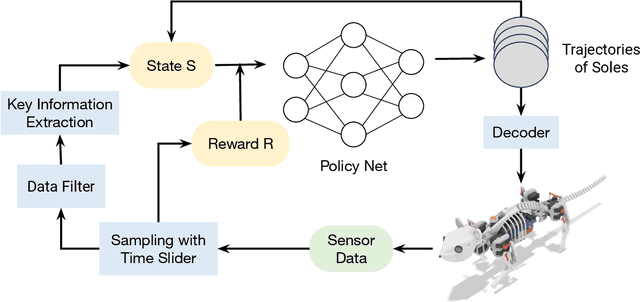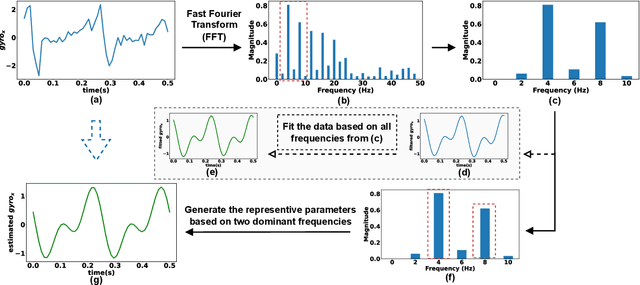Xiangtong Yao
CLAPS: A CLIP-Unified Auto-Prompt Segmentation for Multi-Modal Retinal Imaging
Sep 10, 2025Abstract:Recent advancements in foundation models, such as the Segment Anything Model (SAM), have significantly impacted medical image segmentation, especially in retinal imaging, where precise segmentation is vital for diagnosis. Despite this progress, current methods face critical challenges: 1) modality ambiguity in textual disease descriptions, 2) a continued reliance on manual prompting for SAM-based workflows, and 3) a lack of a unified framework, with most methods being modality- and task-specific. To overcome these hurdles, we propose CLIP-unified Auto-Prompt Segmentation (\CLAPS), a novel method for unified segmentation across diverse tasks and modalities in retinal imaging. Our approach begins by pre-training a CLIP-based image encoder on a large, multi-modal retinal dataset to handle data scarcity and distribution imbalance. We then leverage GroundingDINO to automatically generate spatial bounding box prompts by detecting local lesions. To unify tasks and resolve ambiguity, we use text prompts enhanced with a unique "modality signature" for each imaging modality. Ultimately, these automated textual and spatial prompts guide SAM to execute precise segmentation, creating a fully automated and unified pipeline. Extensive experiments on 12 diverse datasets across 11 critical segmentation categories show that CLAPS achieves performance on par with specialized expert models while surpassing existing benchmarks across most metrics, demonstrating its broad generalizability as a foundation model.
UOPSL: Unpaired OCT Predilection Sites Learning for Fundus Image Diagnosis Augmentation
Sep 10, 2025Abstract:Significant advancements in AI-driven multimodal medical image diagnosis have led to substantial improvements in ophthalmic disease identification in recent years. However, acquiring paired multimodal ophthalmic images remains prohibitively expensive. While fundus photography is simple and cost-effective, the limited availability of OCT data and inherent modality imbalance hinder further progress. Conventional approaches that rely solely on fundus or textual features often fail to capture fine-grained spatial information, as each imaging modality provides distinct cues about lesion predilection sites. In this study, we propose a novel unpaired multimodal framework \UOPSL that utilizes extensive OCT-derived spatial priors to dynamically identify predilection sites, enhancing fundus image-based disease recognition. Our approach bridges unpaired fundus and OCTs via extended disease text descriptions. Initially, we employ contrastive learning on a large corpus of unpaired OCT and fundus images while simultaneously learning the predilection sites matrix in the OCT latent space. Through extensive optimization, this matrix captures lesion localization patterns within the OCT feature space. During the fine-tuning or inference phase of the downstream classification task based solely on fundus images, where paired OCT data is unavailable, we eliminate OCT input and utilize the predilection sites matrix to assist in fundus image classification learning. Extensive experiments conducted on 9 diverse datasets across 28 critical categories demonstrate that our framework outperforms existing benchmarks.
Data-Agnostic Robotic Long-Horizon Manipulation with Vision-Language-Guided Closed-Loop Feedback
Mar 27, 2025Abstract:Recent advances in language-conditioned robotic manipulation have leveraged imitation and reinforcement learning to enable robots to execute tasks from human commands. However, these methods often suffer from limited generalization, adaptability, and the lack of large-scale specialized datasets, unlike data-rich domains such as computer vision, making long-horizon task execution challenging. To address these gaps, we introduce DAHLIA, a data-agnostic framework for language-conditioned long-horizon robotic manipulation, leveraging large language models (LLMs) for real-time task planning and execution. DAHLIA employs a dual-tunnel architecture, where an LLM-powered planner collaborates with co-planners to decompose tasks and generate executable plans, while a reporter LLM provides closed-loop feedback, enabling adaptive re-planning and ensuring task recovery from potential failures. Moreover, DAHLIA integrates chain-of-thought (CoT) in task reasoning and temporal abstraction for efficient action execution, enhancing traceability and robustness. Our framework demonstrates state-of-the-art performance across diverse long-horizon tasks, achieving strong generalization in both simulated and real-world scenarios. Videos and code are available at https://ghiara.github.io/DAHLIA/.
Pretrained Bayesian Non-parametric Knowledge Prior in Robotic Long-Horizon Reinforcement Learning
Mar 27, 2025



Abstract:Reinforcement learning (RL) methods typically learn new tasks from scratch, often disregarding prior knowledge that could accelerate the learning process. While some methods incorporate previously learned skills, they usually rely on a fixed structure, such as a single Gaussian distribution, to define skill priors. This rigid assumption can restrict the diversity and flexibility of skills, particularly in complex, long-horizon tasks. In this work, we introduce a method that models potential primitive skill motions as having non-parametric properties with an unknown number of underlying features. We utilize a Bayesian non-parametric model, specifically Dirichlet Process Mixtures, enhanced with birth and merge heuristics, to pre-train a skill prior that effectively captures the diverse nature of skills. Additionally, the learned skills are explicitly trackable within the prior space, enhancing interpretability and control. By integrating this flexible skill prior into an RL framework, our approach surpasses existing methods in long-horizon manipulation tasks, enabling more efficient skill transfer and task success in complex environments. Our findings show that a richer, non-parametric representation of skill priors significantly improves both the learning and execution of challenging robotic tasks. All data, code, and videos are available at https://ghiara.github.io/HELIOS/.
Predicting the Road Ahead: A Knowledge Graph based Foundation Model for Scene Understanding in Autonomous Driving
Mar 24, 2025Abstract:The autonomous driving field has seen remarkable advancements in various topics, such as object recognition, trajectory prediction, and motion planning. However, current approaches face limitations in effectively comprehending the complex evolutions of driving scenes over time. This paper proposes FM4SU, a novel methodology for training a symbolic foundation model (FM) for scene understanding in autonomous driving. It leverages knowledge graphs (KGs) to capture sensory observation along with domain knowledge such as road topology, traffic rules, or complex interactions between traffic participants. A bird's eye view (BEV) symbolic representation is extracted from the KG for each driving scene, including the spatio-temporal information among the objects across the scenes. The BEV representation is serialized into a sequence of tokens and given to pre-trained language models (PLMs) for learning an inherent understanding of the co-occurrence among driving scene elements and generating predictions on the next scenes. We conducted a number of experiments using the nuScenes dataset and KG in various scenarios. The results demonstrate that fine-tuned models achieve significantly higher accuracy in all tasks. The fine-tuned T5 model achieved a next scene prediction accuracy of 86.7%. This paper concludes that FM4SU offers a promising foundation for developing more comprehensive models for scene understanding in autonomous driving.
Pick-and-place Manipulation Across Grippers Without Retraining: A Learning-optimization Diffusion Policy Approach
Feb 21, 2025Abstract:Current robotic pick-and-place policies typically require consistent gripper configurations across training and inference. This constraint imposes high retraining or fine-tuning costs, especially for imitation learning-based approaches, when adapting to new end-effectors. To mitigate this issue, we present a diffusion-based policy with a hybrid learning-optimization framework, enabling zero-shot adaptation to novel grippers without additional data collection for retraining policy. During training, the policy learns manipulation primitives from demonstrations collected using a base gripper. At inference, a diffusion-based optimization strategy dynamically enforces kinematic and safety constraints, ensuring that generated trajectories align with the physical properties of unseen grippers. This is achieved through a constrained denoising procedure that adapts trajectories to gripper-specific parameters (e.g., tool-center-point offsets, jaw widths) while preserving collision avoidance and task feasibility. We validate our method on a Franka Panda robot across six gripper configurations, including 3D-printed fingertips, flexible silicone gripper, and Robotiq 2F-85 gripper. Our approach achieves a 93.3% average task success rate across grippers (vs. 23.3-26.7% for diffusion policy baselines), supporting tool-center-point variations of 16-23.5 cm and jaw widths of 7.5-11.5 cm. The results demonstrate that constrained diffusion enables robust cross-gripper manipulation while maintaining the sample efficiency of imitation learning, eliminating the need for gripper-specific retraining. Video and code are available at https://github.com/yaoxt3/GADP.
Locomotion Generation for a Rat Robot based on Environmental Changes via Reinforcement Learning
Mar 19, 2024



Abstract:This research focuses on developing reinforcement learning approaches for the locomotion generation of small-size quadruped robots. The rat robot NeRmo is employed as the experimental platform. Due to the constrained volume, small-size quadruped robots typically possess fewer and weaker sensors, resulting in difficulty in accurately perceiving and responding to environmental changes. In this context, insufficient and imprecise feedback data from sensors makes it difficult to generate adaptive locomotion based on reinforcement learning. To overcome these challenges, this paper proposes a novel reinforcement learning approach that focuses on extracting effective perceptual information to enhance the environmental adaptability of small-size quadruped robots. According to the frequency of a robot's gait stride, key information of sensor data is analyzed utilizing sinusoidal functions derived from Fourier transform results. Additionally, a multifunctional reward mechanism is proposed to generate adaptive locomotion in different tasks. Extensive simulations are conducted to assess the effectiveness of the proposed reinforcement learning approach in generating rat robot locomotion in various environments. The experiment results illustrate the capability of the proposed approach to maintain stable locomotion of a rat robot across different terrains, including ramps, stairs, and spiral stairs.
Real-Time Adaptive Safety-Critical Control with Gaussian Processes in High-Order Uncertain Models
Mar 05, 2024Abstract:This paper presents an adaptive online learning framework for systems with uncertain parameters to ensure safety-critical control in non-stationary environments. Our approach consists of two phases. The initial phase is centered on a novel sparse Gaussian process (GP) framework. We first integrate a forgetting factor to refine a variational sparse GP algorithm, thus enhancing its adaptability. Subsequently, the hyperparameters of the Gaussian model are trained with a specially compound kernel, and the Gaussian model's online inferential capability and computational efficiency are strengthened by updating a solitary inducing point derived from new samples, in conjunction with the learned hyperparameters. In the second phase, we propose a safety filter based on high-order control barrier functions (HOCBFs), synergized with the previously trained learning model. By leveraging the compound kernel from the first phase, we effectively address the inherent limitations of GPs in handling high-dimensional problems for real-time applications. The derived controller ensures a rigorous lower bound on the probability of satisfying the safety specification. Finally, the efficacy of our proposed algorithm is demonstrated through real-time obstacle avoidance experiments executed using both a simulation platform and a real-world 7-DOF robot.
Online Efficient Safety-Critical Control for Mobile Robots in Unknown Dynamic Multi-Obstacle Environments
Feb 26, 2024Abstract:This paper proposes a LiDAR-based goal-seeking and exploration framework, addressing the efficiency of online obstacle avoidance in unstructured environments populated with static and moving obstacles. This framework addresses two significant challenges associated with traditional dynamic control barrier functions (D-CBFs): their online construction and the diminished real-time performance caused by utilizing multiple D-CBFs. To tackle the first challenge, the framework's perception component begins with clustering point clouds via the DBSCAN algorithm, followed by encapsulating these clusters with the minimum bounding ellipses (MBEs) algorithm to create elliptical representations. By comparing the current state of MBEs with those stored from previous moments, the differentiation between static and dynamic obstacles is realized, and the Kalman filter is utilized to predict the movements of the latter. Such analysis facilitates the D-CBF's online construction for each MBE. To tackle the second challenge, we introduce buffer zones, generating Type-II D-CBFs online for each identified obstacle. Utilizing these buffer zones as activation areas substantially reduces the number of D-CBFs that need to be activated. Upon entering these buffer zones, the system prioritizes safety, autonomously navigating safe paths, and hence referred to as the exploration mode. Exiting these buffer zones triggers the system's transition to goal-seeking mode. We demonstrate that the system's states under this framework achieve safety and asymptotic stabilization. Experimental results in simulated and real-world environments have validated our framework's capability, allowing a LiDAR-equipped mobile robot to efficiently and safely reach the desired location within dynamic environments containing multiple obstacles.
Language-conditioned Learning for Robotic Manipulation: A Survey
Dec 17, 2023Abstract:Language-conditioned robotic manipulation represents a cutting-edge area of research, enabling seamless communication and cooperation between humans and robotic agents. This field focuses on teaching robotic systems to comprehend and execute instructions conveyed in natural language. To achieve this, the development of robust language understanding models capable of extracting actionable insights from textual input is essential. In this comprehensive survey, we systematically explore recent advancements in language-conditioned approaches within the context of robotic manipulation. We analyze these approaches based on their learning paradigms, which encompass reinforcement learning, imitation learning, and the integration of foundational models, such as large language models and vision-language models. Furthermore, we conduct an in-depth comparative analysis, considering aspects like semantic information extraction, environment & evaluation, auxiliary tasks, and task representation. Finally, we outline potential future research directions in the realm of language-conditioned learning for robotic manipulation, with the topic of generalization capabilities and safety issues.
 Add to Chrome
Add to Chrome Add to Firefox
Add to Firefox Add to Edge
Add to Edge